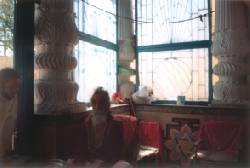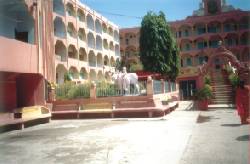|
Travel
Glimpses of Haridwar
Nahar Siddique

The exquisite Ganga near Harki Pauri where "Arati" is held.
When I travel to see new places and meet different people of different cultures, the 'connection of delight' becomes the sole purpose. To me, 'connection of delight' has many manifestations; undiluted pleasure, immense fun, and, most importantly, renewal of friendship and discovering new friends. All the differences and doubts vanish; Nature unfolds its all-pervading beauty and bestows its bounties. I feel a part of Nature and surrender to its captivity. Prof Radhakrishna, a close friend of ours, organised the entire tour programme lasting 25 days. Prof Radhakrishna, a well-travelled person, exhibited an extraordinary knowledge of historical anecdotes, architectural features and aesthetic beauty associated with the places, relics and personalities. The hospitality of the Indian couple extended to us was simply wonderful.
My story is confined to our visit to Hardwar or Haridwar (Bangalis pronounce it Hariddar). According to Hindu faith, Har is Shiva. Hari is Vishnu, Dwar means gate. So, Hardwar or Haridwar is gateway to Sri Kethernath and Sri Badrinath, the holy shrines of Har and Hari. Maha-Kumba Mela is held once in 12 years in Haridwar (also in Allahabad, Nasik and Ujjain). There are fixed days during the mela for bathing in the Ganges waters. Millions of Hindus assemble at these places of pilgrimage to take advantage of the holy bath. Half-Kumba Mela is held every six years. As a gateway to heaven, Haridwar attracts religious Hindus, particularly in old age.

Mata Lal Devi temple |
To me, the most fascinating experience was observing the mighty Ganges. Originating in the Himalayas and travelling a long steep and gorgeous path through the mountains, the river Ganges enters the relatively plain land at Haridwar. The waters are tamed and guided by well-constructed concrete banks and roads. Elevated platforms are constructed stretching into almost half the width inside the river to accommodate hundreds of pilgrims and visitors who would witness the well-organised rituals. 'Arati' is performed with musical background in the evening to the amazement of viewers. Every session of 'Arati' is over with a resounding slogan, 'Ganga Mai Ki Jai' (Long Live Mother Ganga). As the flow of the waters is quite fast and a little turbulent, the streams seem to take away all the human ills and fatigue, leaving behind a sense of fulfillment and rejuvenations.
There are about 500 Dharmashalas in Haridwar. First we went to an ordinary Dharmashala. The rooms, accommodation facilities, doors etc. seemed to be very ordinary; but the room rent was very cheap. Next we went to another Dharmshala which belonged to the other end of the continuum. It was really grand. The welcoming officials told us that there is no fixed room rent. The visitors can pay any amount they want. The clean rooms, good facilities and the environment surrounded by trees speak of high quality. At the entrance, there was a sculpture of Krishna (Shyam) with the flute and the symbolic cow. I could visualise how the eternal melody of the flute would mesmerise the love-laden Radha who would come out to court Shyam.
At the very entrance of this Dharmashala, small shops were selling metal and semi-precious stone jewellery. I bought some as souvenirs. Necklaces of 'nabaratna' were attracting the ladies. It is a belief that wearing these necklaces of nine different kinds of stones provides eternal mental peace.

The Brahmacharian inside Daksh Mandir. |
In Haridwar, only vegetarian dishes are served in hotels and restaurants. The population there is reportedly vegetarian. No animal meat and fish are available in Haridwar. Even egg is not taken here. My husband was a little surprised when the hotel staff politely said 'no' about serving eggs. So, we became completely vegetarian. In fact, we were vegetarian for the entire tour. The two Indian couples who were from South India were completely vegetarian and we enjoyed the vegetable dishes. There is a variety of ways the vegetable dishes are prepared. Vegetable biriyani, nauratan curry, palak panir and a host of other provide plenty of choices. Chola batura, kulcha etc, during breakfast are really tasty. The addition of panir, kaju badam, cream etc, compensate for protein deficiency. Indians take plenty of milk and milk products. Use of ghee is lavish. Although vegetarian, the Indians consume plenty of dishes rich in fat and cholesterol.
Haridwar is a place of temples. We first entered into Daksh Temple. According to Hindu mythology, 'Daksh' is the child of 'Brahma'. The daughter of 'Daksh' is 'Sati' who is also the wife of 'Shiva.' Daksh organised a grand ceremony and invited all, excepting 'Shiva' and 'Sati.' Sati, being the daughter, attended even without invitation. Hearing scathing criticism of 'Shiva' by her father, Sati had a pre-mature death. With deep shock, 'Shiva' started a dreadful dance with the dead body of 'Sati' in his shoulder. When the balance of creation was at stake, 'Lord Bishnu' intervened. His magical cross cut the body of 'Sati' into pieces and spread them throughout the earth. 'Shiva' was transformed into another shape, and then the earth became stable.
Permission was needed to enter the temple. I took some photographs of the inside of the temple on payment. A religious person was sitting in a meditating posture and seemed to be silently uttering verses. Mrs Radhakrishna informed me that these devotees (Brahmacharin) avoid the company of women. I sought his permission to take his photographs. He declined. But his colleague accorded permission. I took the photograph. Fortunately, our husbands were not there to discourage us to take this type of small adventure. The roaring Ganges was flowing by the right side of the temple with lean but speedy current. We met another old devotee near the waters. I took his photograph. With a profound voice, one priest uttered verses and blessed us with Ganges water. The blessings covered the entire range of people from our ancestors to the present generation. It seemed the practice of seeking divine blessings is similar in all religions. The blessings crossed the limits of time and space.
 The Grand Dharmashala The Grand Dharmashala |
We then visited many other temples. Among them are Bharat Mata temple, Bishnu temple, Paban Dev temple, Mata Lal temple and Changi Devi temple. We went near the Monsha Devi temple. Unfortunately, we had either to walk the rest of the distance or to go by the ropeway. The sun was over our heads. Moreover, we were tired after travelling for the last few days. We didn't go any further. We saw from a distance the temple Bansha Devi situated in a small hillock of Bishwa mountain. People travel by ropeway to the temple.
The hillock with the temple remains covered with white snow during winter and looks spectacular. Tagore once said on seeing a temple. 'I studied almost a book. I quite comprehended that this stone has a lot to speak. These words are stunned to silence for centuries; the silent words shake the heart more profoundly.'
People of all nationalities are bonded by the common definition of mankind. The waters of the Ganges that carry all the rituals of Hindu culture enter Bangladesh in the name of Padma, and again carry all the rituals of the Muslim culture without discrimination, and finally culminate in the sea. If nature does not discriminate, why should mankind?
Copyright
(R) thedailystar.net 2005
|
